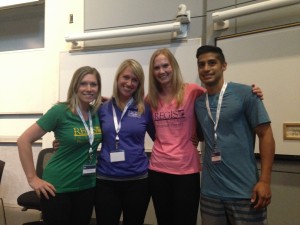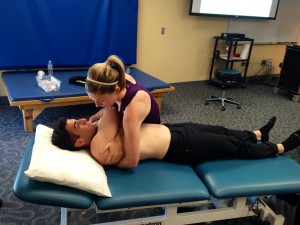Residencies seem to the hot topic now that I have entered the third and final year of my DPT program. Residencies are designed to help build a specialization as well as foster mentorship and increase clinical reasoning skills. If completing an APTA accredited residency you are eligible to take the OCS, NCS or other specialization designation test sooner. (More details about that here.) Deciding to pursue a residency after graduating from a DPT program is a big undertaking and should be well researched and understood by the student. You can find a great comprehensive list of residencies in different areas of specialization here. The point of this post is not to discuss to many different kinds of residency models but instead to discuss some topics that #DPTstudents should be aware of before diving head first into post DPT residency.
Let me start with a little background on why I decided to ask clinic owners or hiring managers their thoughts on residencies. I was discussing the many options of post DPT graduation residencies with my husband. With a confused look on his face he said, “I don’t understand. You will have just finished 3 years of a doctorate program but you need to do a year or longer residency to land a job that would pay you exactly the same as if you hadn’t done the residency?” I wasn’t sure how to answer his question. Would I make more if I did a residency? Would I be a better candidate or would I just be considered a silly new grad who happens to be more in debt? Would an employer be willing to help me pay for it? (Please note that there are residencies that pay you as a full time employee and incorporate mentoring hours and clinical hours. In my case, I want to stay in Colorado so I have only been looking into distance based residency programs with weekend hands-on intensives. I also want to begin my career where I plan to live for the foreseeable future just as a personal choice. Ok, back to the topic!)
I made a short survey and with the power of Twitter I was able to get 35 clinic owners or hiring managers to complete the survey and many offered additional comments. The n=35 is not statistically significant but I think it gives a good insight regardless. This is what they had to say.
Question 1: Does completing a residency increase a new grads chance of being hired?
YES. 66.6% said yes, 33.3% said no. Many of the comments that accompanied this question stated that a residency provides more experience and mentoring (read: “less needy”) and therefor the student would be perceived as a better candidate. However, some of the comments were not along these lines such as “I would not give a residency grad higher priority than I would to a well-informed, motivated and articulate new DPT who has not gone through a residency.”
Question 2: Is the salary higher for a residency grad vs a new DPT grad?
You have a 50/50 shot at making more money as a residency grad. The results were split right down the middle (one person did not answer this question). Many of the comments on this question stated that just because a new PT graduated from a residency program does not mean they are able to bill the patient more for their time. One commenter stated that often times residency grads request a higher salary but the skills they bring have not brought extra value to the clinic. This owner/ hiring manager states “you have to look at what type of value/niche the potential PTs residency brings to the practice and community. We pay people based on the individual value they bring.” It’s all about value.
Question 3: As an employer, do you offer any assistance for an employee wanting to complete a residency?
I was really surprised by the answers and comments on this question. The majority (50%) do not offer any assistance on continuing education including a residency, 30% offer some continuing education budget, and 20% of the respondents host a residency in their clinic. Many of the comments posted on this question simply stated that as a small private practice, this is too big of a financial burden to provide a continuing education budget. One responder said they would support an employee wanting to pursue a residency but there would be pay back stipulations if a certain time commitment of employment was not met.
Question 4: Do you have any other thoughts you would like to share regarding new DPT grads exploring residency programs?
I will let these comments speak for themselves:
I think that we do our profession harm if we imply a residency is the only way to specialize. I think it’s great that it’s an option, but it’s too soon (at least in women’s health) to determine a good cost-benefit analysis.
Therapists who complete the residency programs may have didactic knowledge, however the clinical translation is a value lost on my practice. I would suggest a 2-3 year level of experience prior to attending a residency as a criteria, a new grad is a new grad- residency or otherwise.
I encourage new grads to do a residency is they have the financial means. If they don’t, then I think they should think twice
I think it’s a great idea to explore a residency if you can support yourself on a potential lower salary for awhile.
I think a residency is a fantastic thing to do for the motivated individual to take their practice to the highest level. However, I do not believe that increased pay or anything to that effect should be the motivating factor to pursue a residency.
If you are in a position to attend one, great. The mentoring and experience should be beneficial. But do not think that it is the only path to excellence. As an employer, I would prefer a keen, passionate and well informed new grad over one who has been groomed to follow outdated paradigms and has become a follower of any one particular technique (i.e. McKenzie, Paris or Dry Needling). I much prefer a strong critical thinker who is willing to apply uncomfortable truths about research and evidence into the practice of PT. I do not see this push in residency programs so far.
I found the results and comments posted on my little research study to be very eye opening. I hope this helps you put things into perspective as it did for me. Attending a residency can be very beneficial in many ways, but think twice and ask many questions before jumping in as a residency is not the only way to success.





